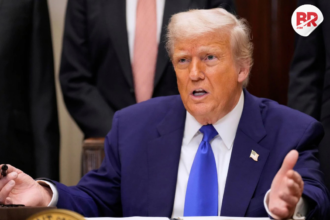
The Tariff Truce: A Short-Term Calm in a Volatile Global Economy
When President Trump’s “tariff truce” made headlines, it was seen as a brief relief for global markets. But let’s not mistake this momentary pause for a solution. Beneath the surface, deeper economic shifts are still shaking the foundations of world trade and business.

The Illusion of Stability
Whenever trade tensions ease, there’s usually an immediate surge of optimism. Markets breathe a sigh of relief, stocks rise, and news outlets proclaim a victory for diplomacy. But the tariff truce wasn’t a resolution. It was merely a temporary break—a pause in a much larger ongoing game of global economic chess.
Focusing on these short-term gains can be misleading. While some saw the truce as a win, it only masked the deeper, more complex issues affecting global trade. The world order that Trump sought to reshape remains in flux. And that uncertainty lingers, quietly shaping the future.
Also Read:: Trump Just Hinted at Tariff Exceptions—The Reason Will Surprise You!
Beyond Tariffs: A World Order in Flux
The tariffs were never just about taxes on imports and exports. They were a strategic attempt to change how nations interact with each other. Trump’s economic nationalism aimed to challenge multilateral agreements, prioritize bilateral deals, and even shift global power dynamics.
While some of these policies were rolled back, their effects are still being felt. Businesses are now dealing with:
- Erosion of Trust: Sudden policy shifts have left governments and businesses wary. Long-term investments are now being made with greater caution and uncertainty.
- Supply Chain Disruption: Companies have scrambled to shift supply chains, moving away from reliance on single countries. This change has been costly and time-consuming.
- Geopolitical Realignment: Nations are rethinking their alliances, as economic powers shift and new partnerships emerge to balance the global stage.
The Indian Perspective: A Chance for Growth
For countries like India, these economic tremors present both challenges and opportunities. On one hand, we face growing competition and greater uncertainty in export markets. On the other, India is in a unique position to attract foreign investment and become a major manufacturing hub.
As businesses look to move production away from China, India could benefit greatly. However, this opportunity comes with its own set of challenges. India must improve infrastructure, streamline regulations, and create a more business-friendly environment to capitalize on these global shifts. The future of India’s economy depends on how well it navigates these opportunities.
The Ever-Present Threat of Policy Whiplash
One of the most unsettling aspects of the Trump era was the constant unpredictability. Policies were often introduced with little warning, leaving businesses scrambling. Even with a new administration, the scars of this “policy whiplash” remain. Companies are now more risk-averse, less willing to make long-term commitments.
This unpredictability has forced a shift in how businesses approach investments. We are all a little more cautious, aren’t we? The constant state of flux has made long-term planning more difficult than ever.
Navigating a Volatile World
So, what can businesses and investors do in this unpredictable environment? Here are a few strategies:
- Diversify Investments: Don’t rely too heavily on any one market or asset class. Diversification is key to weathering any storm.
- Focus on Long-Term Value: Look for businesses with strong fundamentals—companies that are well-positioned for sustained growth, regardless of market turbulence.
- Stay Informed: Knowledge is power. Keep track of global developments and policy changes that could affect your business or investments.
- Think Long-Term: Short-term fluctuations are inevitable, but focusing on long-term growth will help you stay grounded.
Economic Tremors Still Resonate
While the tariff truce offered a temporary sense of stability, the underlying economic tremors caused by policy shifts and nationalism are far from over. As businesses, investors, and individuals, we must remain adaptable, vigilant, and informed. The path ahead may be rocky, but with the right strategies, we can navigate the challenges ahead and seize the opportunities that come our way.
Also Read: Is Trump Using Market Manipulation for Personal Gain? The Controversial Tariff Pause












